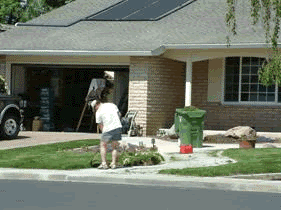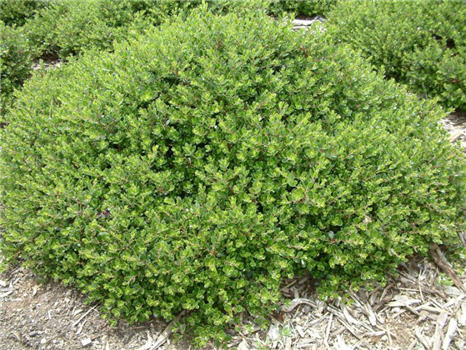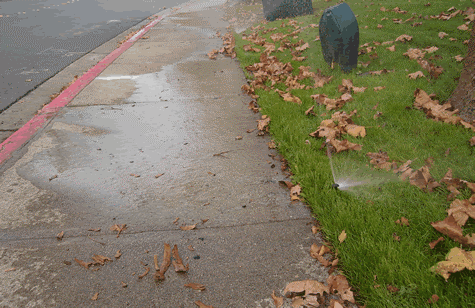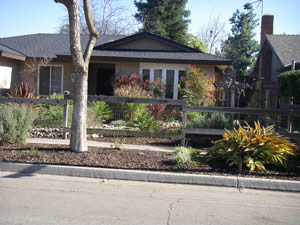- TABLE OF CONTENTS
- DESIGN
- Introduction to Design
- Active Family
- Empty Nesters
- Young Professionals
- Questionnaire
- Principles of Design
- Design Concepts
- Working With Professionals
- Drainage
- Soil
- Climate/Weather
- Safety
- Landscape & Irrigation Plans
- Landscape Design
- Installing the Garden
- Hydrozoning
- Public and Demonstration Gardens
- Xeriscape
- Garden Care
- Composting
- Lawn
- Maintaining Your Garden
- Plant Water Needs
- Mulch
- Pest Management
- Growing a Healthy Garden
- Reading a Pesticide Label
- Pruning Landscape Plants
- Planting Instructions
- IRRIGATION
- Irrigation 101
- Types of Irrigation Systems
- Upgrading Existing System
- Choosing an Irrigation Control System
- Irrigation, Maintenance and Troubleshooting
- Eliminating Run-off and Overspray
- Acknowledgments
Lawn
Lawns consume more water than all the other plants combined in your garden and require more frequent maintenance. If you plan to include a lawn in your landscape, consider making the size 20% or less of your entire garden or use a lawn alternative. This will help make landscape watering and maintenance more manageable.

Hard at work on the front lawn.
Consider having lawn only in necessary areas that will use the space and that type of plant material.

While a lawn provides a soft surface for children’s play and sports activities, entertaining, and for pets, not every garden needs a lawn. Consider substituting with a groundcover; go to Plant Lists under Plants on the Main Menu.

Manzanita Emerald Carpet ground cover is an attractive alternative to lawn.
Selecting a type of lawn:
There are two basic types of lawn to choose from in Fresno:
| • | Warm-season grass, for example, Bermuda, hybrid Bermuda, St. Augustine, Buffalograss (see below), Zoysia |
| • | Cool-season grass, for example, tall fescue, perennial rye |
There are pros and cons to all of these grasses.
Warm-season grass |
Cool-season grass |
Requires about 40% less water |
High water user |
Thrives in full sun but dies out in shade |
Tolerant of light shade |
Goes dormant during the winter |
Stays evergreen year round |
Spreads by rhizomes, which allows damaged areas to grow together but also can invade adjacent flower beds |
Does not spread so damaged areas needs to be repaired by overseeding. Will not grow together or invade flower beds. |
Tips for a healthy lawn:
| • | A smart controller, or a regular controller with a cycle and soak feature, will better control the amount of water applied and allowed to soak into the ground. Evaluate your sprinkler system. Inspect, fine tune, and if necessary, upgrade your existing sprinkler system to save water. |
| • | Fertilize your lawn only as necessary. Fertilizer contains nitrogen, and too much nitrogen encourages fast growth. |
| • | In place of store-bought fertilizers, try to fertilize your lawn naturally. Compost returns needed bacteria, enzymes, and nutrients to the soil. Another option is to make your lawn self-fertilizing by including clover or other nitrogen-enhancing plants in the lawn. |
| • | Hand-pull weeds as they appear. Weeds rob your lawn of water and nutrients while crowding out desirable grasses. Apply a pre-emergent herbicide (prevents weed germination) for major weed infestations. |
| • | Mow grass to the following heights: 2 to 2 ½ inches for fescue. 2 to 3 inches for tall fescue. 2 inches for common Bermuda. 1 to 1 ½ inches for hybrid Bermuda. Consider purchasing a grasscycling mower. |
| • | Cut turf grass away from sprinkler heads. |
| • | Aerate your lawn. Aeration will improve water penetration and encourage deeper roots. The plugs produced by aeration should be left on the lawn, as they can help decompose thatch. |
| • | If bare spots or a thinning lawn is a problem, adjust or redesign the sprinklers to apply water evenly. Water from each sprinkler head should reach adjacent sprinkler heads (“head-to-head” coverage) to maximize even watering. |
| • | Adjust sprinklers to water planting areas only. Avoid watering sidewalks, driveways, patios, and structures. |
| • | Watering your lawn in several short cycles is better than one long cycle. Dividing the watering time into pieces and having one hour between start times will reduce irrigation run-off. If you own a smart controller, the controller will apply water slowly and in cycles to allow the soil to absorb the water and prevent run-off. |

Watering time is too long, resulting in run-off.
| • | Water infrequently but thoroughly. Watering to a depth of four to six inches will encourage deeper, healthier root development and allow the turf to withstand short periods of drought and sudden temperature changes. (See Watering Guide on the Main Menu) |
| • | It is not advisable to plant a tree in your lawn, particularly native oaks. Many trees are susceptible to Armillaria mellea (root rot) if they receive as much water as is needed for a healthy lawn. As the tree matures, the lawn will get less and less sunlight resulting in gradual decline until there is no lawn, yet the tree will continue to receive the water and very possibly develop the disease. Also, watering a lawn placed under a tree causes the roots of the tree to grow toward the surface rather than down, causing instability and a very lumpy yard. Trees often suffer damage from lawn mowers and weed eaters if lawn is grown next to the trunk. Instead of lawn, use an attractive layer of mulch under trees. |

Mulch under tree
Bermudagrass
Cynodon dactylon
Understanding its growth habits so that you may effectively eliminate it.
Bermuda is a valued low water use warm-season perennial turf grass which goes into dormancy when temperatures drop below 50 degrees F; it can also go into a drought dormancy by late summer if it does not receive some summer irrigation. During either dormancy the grass turns brown or straw colored. The key word is dormancy-it is just resting until circumstances are right for it to wake up.
Common Bermuda is more aggressive than Hybrid Bermuda. Common Bermuda spreads rapidly by surface and underground shoots (runners) which may extend 18” to 24” before they develop roots; and in sandy soil roots may grow several feet deep. If not mown frequently it will set seed on spikes that stand 4” to 6” tall. The seed is easily dispersed by the wind and will germinate easily during our warm months with irrigation. Hybrid Bermuda has shorter shoots and is not as aggressive as Common Bermuda. Further, Hybrid Bermuda will not grow from seed as it is sterile so it only multiples by its shoots.
Each node (bulbous spot), on both surface and underground shoots, has the ability to develop roots. These shoots even if removed from the parent plant can develop roots and grow if irrigated during the warm time of year; and can lie in the soil during either type of dormancy and sprout when the conditions are right.
This means any shoot, even if it has only one node, can lead to Bermuda grass reestablishing itself where you do not want it to grow. Therefore, if you are trying to eliminate a Bermuda lawn to establish a garden bed or a different type of lawn you must effectively eliminate all the surface and underground shoots.
Because of its growth cycle the most effective time to eliminate Bermuda is during the warm growing months-May to September. Any approach to eliminating Bermuda will require at least three and possibly four attempts at eliminating the shoots over a period of three to four months. These approaches include digging, chemicals, and combining digging and chemicals. With any approach you continue regular irrigation so that any of the remaining Bermuda will sprout and grow so that you may find it and eliminate it.
The most effective way to dig out the Bermuda requires sifting the soil for runners. You may start digging before the Bermuda is out of dormancy, however, you will need to wait until the growing season in order to have the shoots not dug out sprout and find their way to the surface. Continue regular irrigation so that any shoots not removed will sprout. You will need to wait up to 5 or 6 weeks between diggings so that the Bermuda has had time to sprout and reach the surface. This is the environmentally safe approach.
The chemical approach requires that you wait for the Bermuda to come out of dormancy- become actively growing- as the chemical will not be absorbed by dormant Bermuda and, therefore, cannot kill the Bermuda. Spray the Bermuda lawn with the appropriate chemical following label directions and continue with normal irrigations. It will take one to two weeks before you start to see evidence that the chemical is working. In a month or more when you see new Bermuda sprouting you will chemically spot treat the green growing areas (No need to spray something that is already dead) and again continue to irrigate.
Using the digging and chemical approach combines both approaches. In most instances you probably will want to dig the dead Bermuda out for aesthetic purposes any way. Do the initial digging to get out the majority of Bermuda and then apply chemicals when the Bermuda that was missed starts sprouting, applying only to the green Bermuda. As with the other two approaches keep irrigating between chemical applications.
Chemicals that are developed for killing Bermuda include both non-selective and selective herbicides. A non-selective herbicide may kill any type of plant and a selective herbicide kills specific plants and may not injure other specific plants. Reading the label is absolutely necessary so that you use the correct chemical to get the results you want. Further, following label directions on mixing, usage, and disposal is necessary so you do not contaminate yourself, family, pet, or environment. Using more chemical than the directions call for does not lead to a better or quicker kill of the Bermuda and may injure or kill other plants. Spray when the air is still as drift of the chemical can injure other plants.
See Bermudagrass, Pest Notes, for recommended chemicals.
Recommended Reference:
www.ipm.ucdavis.edu for more information on bemudagrass, other grasses and other weeds.
BUFFALO GRASS
(Buchloe dactyloides)
Buffalo Grass is a warm season perennial grass native to the North American prairies. It is drought-, heat- and cold-resistant and is closely related in its growing habits to Bermudagrass. When actively growing, buffalo grass varieties range from green to blue-green in color with soft, easy-to-walk-on blades, although it is not as hardy as Bermudagrass in high-traffic areas.
Buffalo grass grows between 2 and 5 inches tall and spreads out between six feet and 12 feet and may reach up to 5 feet below ground, with 70% of roots (by weight) occurring in the first 6” of soil. Flower stalks are 4-8” tall. The male inflorescence is a panicle; the female inflorescence consists of short spikelets borne in burlike clusters, usually with two to four spikelets per bur. Buffalo grass sends out numerous branching stolons, and occasionally it also produces rhizomes. Roots are also numerous and thoroughly occupy the soil. In dry seasons it gets brown and stops growing unless irrigated. In winter it turns tan.
Buffalo grass is best planted with plugs. Buffalo grass seed is very difficult to germinate evenly, and sod is rarely available. A new introduction from the University of California is UCVerde Buffalograss (UCVB), which is greener than the native seeded variety. The flowers of UCVB are sterile, so it does not spread by seed nor produce pollen.
New plugs should be watered immediately after planting. The area should be kept wet for the first two weeks, then the watering slowly reduced but the ground should be kept moist. After the fourth week, the area should be soaked once or twice per week until the plugs have completely covered the area. This additional watering will keep the plugs actively growing and spreading as quickly as possible. After this period, additional watering will depend on the natural rainfall and temperatures, as well as soil type. Clay soil will require less water than sandy soil. Water buffalo grass to prevent stress. Buffalo grass is under stress when the grass blades wilt or the tips turn a purplish/brown color.
One of the advantages of buffalo grass is that it does not have to be mowed, but it can be if a more manicured look is preferred. Even if mowing is desired, the frequency might be once a month or once a season instead of once a week. Mowing height is 2.0 inches (as the preferred base height). For best results, mow with a rotary mower. Raise to 2.5 or 3.0 inches in poor soils and/or minimal irrigation.
If you choose to leave the grass uncut, it’s a good idea to mow it once in the early spring to remove the old growth and allow the new growth to be visible. Also, if left uncut, a buffalo grass lawn will have a soft appearance and look nice if accented with some drought tolerant perennials to create the appearance of a short grass prairie.
The one significant limitation of buffalo grass is its intolerance of shade. It may tolerate light, dappled shade but will start to look straggly. It is much hardier and happier in full sun.
BUFFALO GRASS REFERENCES:
http://ucverdebuffalograss.com/
http://www.wildflower.org/howto/show.php?id=19&frontpage=true
http://www.fs.fed.us/database/feis/plants/graminoid/bucdac/all.html
http://ag.arizona.edu/pubs/garden/mg/lawns/growth.html
Artificial turf
A surface manufactured from synthetic fibers made to look like natural grass, is becoming more widely used.
Advantages
- Artificial turf can be a better solution when the environment is particularly hostile to natural grass. An arid environment or one where there is little natural light are examples.
- Artificial turf can withstand significantly more use than natural grass and can therefore be used much more frequently. This allows sports ground owners to generate more income from their facilities.
- Ideal for holiday homes when maintenance of lawns is not practical. It is also a solution for elderly home-owners who find the upkeep of lawns too much hard work.
- Suitable for roof gardens and swimming pool surrounds.
- Some artificial turf systems allow for the integration of durafill. Durafill is the latest in infill technology. It is pet and eco-friendly, withstanding animal urine and elements, preventing the growth of spores and bacteria within the surface. It also prevents degradation throughout time and does not need multiple applications. It does not overheat in the sun, preventing overheating of the actual surface. It does not contain zinc, heavy metals, or silica dust.
- Water can be saved by incorporating artificial turf versus natural grass. Although it does not need irrigated, an occasional hosing helps remove dust.
Disadvantages
- Artificial turf does not support bio-diversity
A diverse landscape may resist disease and insect pests better than those withlittle variety, while providing a higher habitat value - Artificial turf does not foster soil health. Healthy living soil will:
Increase microbial activity which helps cycle nutrients and filter pollutants
Increase water holding capacity
Improve water quality - Production of (virgin) synthetic turf components are associated with significant greenhouse gas emissions
This is increased when considering the entire life cycle, due to related increasesin processing and transportation needs
Artificial turf is not easily recycled
Cost and lack of infrastructure are an issue to end-of -life recycling of artificial turf
It ends up in the landfill - Artificial turf can be a contributor to the heat island effect
Artificial turf has no ability to sequester carbon - Without a built-in drainage system, artificial turf can lead to excessive runoff
Any existing chemicals may runoff directly into storm drains and waterwayswithout the beneficial filtration that live vegetation or mulch provides
Levels of zinc, selenium, lead and cadmium leaching into the groundwater from crumb rubber underlayment may be significant. More research needs to be done (report from Environment and Human Health, Inc: http://www.ehhi.org/reports/turf/ )
Source: City’s of Santa Monica and Santa Rosa